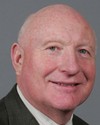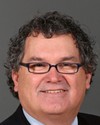Thank you very much, Mr. Chairman.
First of all, allow me to introduce myself. My name is Réginald Cotton, et I am from Rivière-au-Renard in the Gaspé. I am one of the groundfishers who have been forced to fish small, temporary shrimp quotas since the moratorium.
We have provided you with the document on which we have been working for almost a year now. I am the spokesperson for the Association des capitaines-propriétaires de la Gaspésie. I represent nine mid-shore fishermen's associations from the southern gulf. I am the spokesperson for the Association des pêcheurs de la MRC Pabok, for the Regroupement des pêcheurs professionnels des Îles-de-la-Madeleine, for the Association québécoise de l'industrie de la pêche, for the Association des pêcheurs de poisson de fonds acadiens, for the Association des pêcheurs spécialistes indépendants du poisson de fond, for the Association des morutiers professionnels de la Gaspésie, for the Northern Cape Breton Fishing Vessels Association, and for the Prince Edward Island Groundfish Association. Moreover, two governments are working in partnership with us, the Government of Quebec and the Government of Nova Scotia. I represent all those groups.
I am here today because there is an important problem regarding cod in the southern gulf. There is a huge gap between what the science is saying, and what fishers are seeing and catching out at sea. The same thing happen in the northern gulf. The gulf is divided into two parts. The northern gulf is managed separately by Newfoundland and the Institut Maurice-Lamontagne. The southern gulf is managed out of Moncton.
Several years ago, things in the northern gulf changed. Newfoundland fishermen would go fishing, catch cod, and see cod. They said so to the scientists managing the northern gulf, and things improved for them.
Last week, the fishing plan for the northern gulf was announced. Fishermen will be allowed to catch 7,000 tonnes of cod. The biomass is much greater in the southern gulf, and there is talk of instituting a third moratorium. As I said earlier, the fishers and the associations that represent them are seeing a huge gap between what they see and what science perceives. We would like to close that gap and remedy the problem to some extent. We would like to harmonize the fishery in the north and south, which would mean changing certain things.
For example, let me tell you about the tool people in the southern gulf are using to inventory stock — the trawler. They use it to catch cod and inventory cod stocks. That trawler dates back to Noah's time. Even fishermen stopped using it in the 1950s because they could not get it to work. At the same time, there are other things that I will not go into since all those details are in the document we distributed.
The northern gulf stopped using that trawler several years ago. And scientists in the northern gulf say that catches in that sector have gone up fivefold. That does not mean the cod suddenly appeared — it was already there. However, because the inventorying tool works much better, it provides a better picture of what is there. I am not going to go on too long about this, since you have the document.
We are asking the Department of Fisheries and Oceans to do something to improve the data on the southern gulf. For economic reasons, DFO dropped one of the inventorying trips several years ago, so there is no longer a spring inventory. This is the gulf, and in the Gaspé the cod come in during the spring and leave during the fall. I am fairly convinced — as are all fishers and associations that I represent, even the governments I represent — that the best way of measuring cod stocks coming into the Gulf of St. Lawrence is to measure and count the fish that come in in spring.
One major criticism we have is that DFO people — the scientists in Moncton — are measuring stock in the southern gulf in August. That is when they do the inventory. I am probably the only fisher here today, and with good reason, but if you ask all Atlantic fishers, even professionals will agree with me in saying that no one has ever been able to fish for cod in August. I am 57 now, and I have been fishing since I was 16 or 17. It has always been that way. We do not know why.
We, the fishermen, think that it is probably because the cod is living the gulf in the fall in preparation for its migration. I don't know whether this cod is in another water column or in areas where we can't find it, but scientists take advantage of this time of year to take inventory of the stocks. That is one of the main reasons why these people don't have any data. Every time they go out, there are no cod.
I can draw a parallel with the salmon fishery. In our region in the Gaspé Peninsula, there are highly ranked major spawning rivers. At the end of the 1800s, when the Canadian and Quebec governments realized that the Americans were very interested in salmon from the Gaspé, they first tried to inventory the fish stocks. They started to do that inventory when the salmon fishery opened. They realized that they could not find almost any salmon because during the salmon run, the salmon are going back into the river. So when they tried to count the fry in the salmon pools, they could not find very many. It's not that they didn't find any, it's that they didn't see them.
When the light is poor, it is impossible to see the salmon on the bottom. Most of the time, salmon hide behind large rocks. They hide under large tree trunks lying on the bottom of the riverbed. They are impossible to count. Scientists realized over the years, given the great interest in salmon sports fishing, that they could count them during the salmon run. That is why this method is still used today. In most major salmon rivers in Quebec and elsewhere, the salmon are counted during the salmon run, and that is the method that is still used today.
So, an easy way to understand what is happening in the southern part of the Gulf of St. Lawrence is to measure, as we've done in the past, the number of fish running upstream, but using modern methods.
The debate centres around this issue. Since the north has changed because of the trawler, various other things needed to be changed. Whether you are in the northern or southern part of the Gulf of St. Lawrence, even if there is an imaginary line drawn by humans, the cod don't necessarily recognize that line. We're talking about the same species, cod, in both the northern and southern part of the gulf. You can think of the Gulf of St. Lawrence as a lake. Even if it is separated into two, there is no reason to adopt such different methods in the northern and southern gulf.
That is why fishers have had a lot of questions for the past 15 years. The gap is growing exponentially year after year with scientists in the southern gulf, from Moncton. That is why we are here today. We are asking the Canadian government to closely examine this issue. Thanks to the work of scientists, Fisheries and Oceans Canada has quantitative data. But we know full well that thanks to our knowledge and our experience, we can provide it with qualitative data that is as valuable as the quantitative data provided by scientists.
Last summer, I took part in a science exchange in my region, Anse-à-Beaufils, in an old plant that had been renovated into an arts centre. Scientists and academics from all over took part in this exchange. To my great surprise, I was invited to this event as a fisherman by the Government of Quebec and the Canadian government. There were some 100 people in the room, and I was the only fisherman. I wondered what I was doing there, alongside academics with titles as long as your arm. I was a bit surprised. The exchange was on climate change.
I was the first to get questions. I was asked, first, what I thought about climate change and what I had observed at sea. I shared my observations. They all told me that I was completely right. The groundfish are the most sensitive organisms to changes or climate change.
I have been saying that since the end of the 1980s. Even at the end of the 1980s, when we were catching a lot of cod, I was telling scientists that something was happening, because we could no longer catch the cod where we used to. For years, I, my colleagues and representatives of associations have been saying that the migration pattern had changed. But, not much has changed in the southern gulf, scientifically speaking.
Mr. Chair, we are asking our government to give us a chance. In our brief, we are asking for a three-year project, with a TAC of 4,000 tonnes. You might think that 4,000 tonnes is a lot, but for the fishermen in the entire Gulf of St. Lawrence, this is not a lot. I can tell you that, with a TAC of 1,500 to 2,000 tonnes for the southern gulf, the picture will look pretty bleak.
Four thousand tonnes would be appropriate if all the fishermen went out to sea. It is easy today, every fisherman knows what he can catch, be he from the Maritimes, Quebec, the Magdalen Islands or anywhere else. If it were set at 4,000 tonnes, every fisherman would go out. We are asking the government to record and analyze each trip by each fisherman. We strongly believe that the situation would be better than with a moratorium of 2,000 or 500 tonnes.
Mr. Chair, like all those whom I represent, I believe that the worst harm done to the biomass in the southern Gulf of St. Lawrence was the result of the fishery being closed.
Here's an example that I often use when I'm asked to talk about the fisheries. If someone in my family had cancer, I would isolate them in a corner and leave them there. Because they had cancer they would be left to die in peace, even if it took two or three years. Why not take a chance and try to see other doctors or get other medication? It's the same thing with regard to the fishery. We, the fishermen, are here because of our experience, just like the fishermen from Newfoundland. If fishermen from Newfoundland have convinced scientists to change some things we should do the same in the southern gulf.




